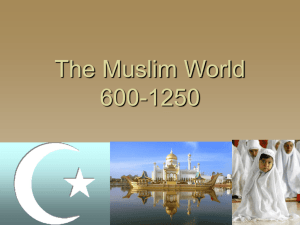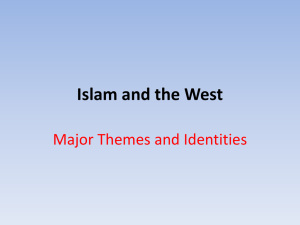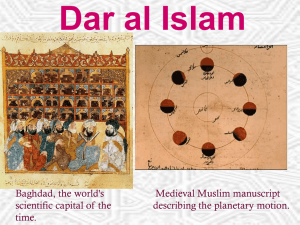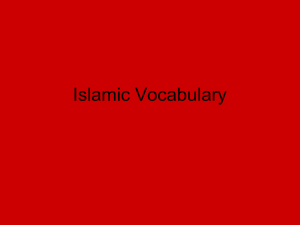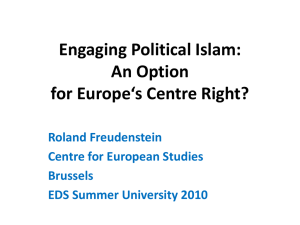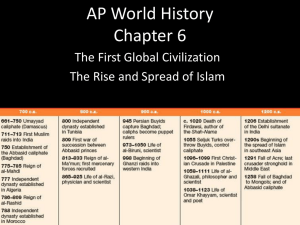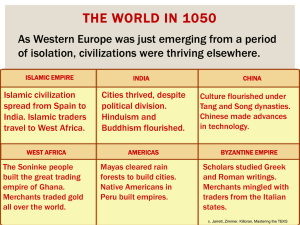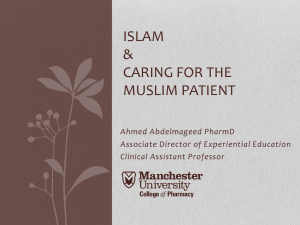Islamic Culture and Art - Central Kitsap High School
advertisement
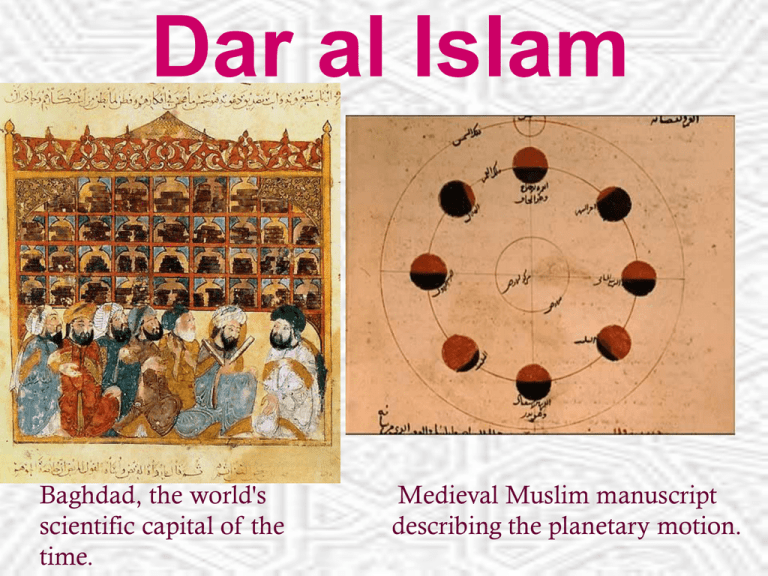
Dar al Islam Muslim scholars in Baghdad, the world's scientific capital of the time. Medieval Muslim manuscript describing the planetary motion. Interactive map http://highered.mcgrawhill.com/sites/0072957549/student_view0/chapter14/int eractive_map_quiz.html Bad map no spain Pt of this ppt: What is Islam How did it spread How/why was this a period of “brilliant flowering of scholarship” Muslim Population Today India/Pakistan/Bangladesh Africa Arab countries Southeast Asia Iran Central Asia China Europe North America South America Australia Worldwide 250-300 Million 200 Million 180 Million 170 Million 50 Million 50 Million 50 Million 20 Million 6 Million 3 Million 1 Million over 1 Billion Country with the MOST Muslims today: Indonesia The Qu’ran -- “the recited” An early manuscript of the Qur'an Muslim: One who submits to the will of God Revealed Prophets Adam Noah Abraham Isaac Ishmael Moses David Solomon Zacharias Elisha Elias John the Baptist Jesus Mohammed The 'Five Pillars' of What is the point of this cartoon? Hajj The annual pilgrimage to Mecca-the Hajj-is an obligation only for those who are physically and financially able to perform it. About two million people go to Mecca annually Pilgrims wear special clothes: simple garments which strip away distinctions of class and culture, so that “all stand equal before Allah.” To see clip of circiling the Kaba http://www.youtube.com/watch? v=YzAJIXwc49A The Ka’baa The place of worship which God commanded Abraham and Ishmael to build over four thousand years ago. The building was constructed of stone on is believed to be the original site of a sanctuary established by Adam. God ordered Abraham to summon all mankind to visit this place. The Black Stone is a significant feature of the Kaaba, stated by Muslims to have been placed there by Ibrahim (Abraham) and Ismail (Ishmael), a stone from paradise sent by the angels to Ibrahim.[ Located at the eastern corner of the Kaaba, it is about 30 cm (12 in) in diameter and surrounded by a silver frame In this 1315 persian illustration, The Islamic prophet Muhammad solves a dispute over lifting the black stone into position at al-Kaaba. - In the center, Prophet Muhammad, with two long hair plaits, places the stone on a carpet held at the four corners by representatives of the four tribes, so that all have the honor of lifting it. The carpet is a kelim from Central Asia. Behind, two other men lift the black curtain which conceals the doors of the sanctuary. This work may be assigned to the Master of the Scenes from the Life of the Prophet The “Golden Age” of Islam under Abbasid Dynasty Astronomy discovered stars compiled astronomical tables and almanacs established observatories Mathematics “Arabic” numerals Zero Algebra, algorithm Inventions quadrant and astrolabe Medicine first hospital – Baghdad 706 surgery emphasized empirical observation hygiene and pharmacology Universities and Libraries Literature Religious Toleration Preservation of GrecoRoman (classical) world Scientists Jaber Ibn Haiyan (Geber) alchemist/metallurgist died 803 CE Ibn Sina (Avicenna) physician/philosopher 981-1037 CE Ar-Razi (Rhazes) physician/ philosopher 864-930 CE Abu Al-Qasim Al-Zahravi (Albucasis) surgeon/author 936-1013 CE Ibn Rushd (Averroes) physician/philosopher 1128-1198 CE Al-Khawarizmi (Algorizm) mathematician/ astronomer 770-840 CE Why such a flowering? “Seek Knowledge Even Unto China” Not the same conflict b/w faith and science as in western Europe Jamelie Hassan Seek Knowledge Even Onto China, 1993-95 vinyl calligraphy and painted wall varying dimensions Collection of the artist Photo: John Tamblyn Why this flowering of arts, science, philosophy? What about the practice of Islam would encourage the pursuit of astronomy and geography? Ibrahim al-Fazari (d. 777 C.E.): constructed the first Muslim astrolabe circa 750 C.E. Cartography Islamic Map of the World 1154, South is at the top Muslim scholars in Baghdat, the world's scientific capital of the time. Islamic scientific manuscripts of the Medieval Age; meticulous studies on human anatomy and zoology. Theme of Dar al Islam: Borrow, Blend, & Build Islamic society originally reflected the nomadic & mercantile Arabian society. Adopted Persian techniques of gov’t & finance and literature after conquering Sassinads. Transmitted Indian & Chinese knowledge via trade & conquest (eg paper making, “Hindu numerals”) Preserved Greek & Roman learning (Aristotle & Plato) …and Created own knowledge! Islamic Art Calligraphy Rugs Literature Music Miniatures Architecture Arabesque and Geometrical Design Arabesque: a style of decoration characterized by intertwining plants and abstract curvilinear motifs. Religious leaders forbade the depiction of animals & people. This style is the essence of decorative Islamic art. Geometric Designs: Intricate patterns emphasizing symmetry and repeated rhythms Calligraphy Islamic leaders saw in figural arts a possible implication of idolatry, so Islam's early theocracy looked to the artistry of calligraphy for religious expression. In Islamic and Arabic cultures, calligraphy became highly respected as an art -- the art of writing. Architecture focus on interior space as opposed to the outside or façade: architecture and decoration that must be experienced by being entered and seen from within.. Feeling of weightlessness -- metaphysical space “Paradise on earth” Vaults & arches, domes, minarets, mihrabs Vibrant blues: Cobalt blue & turquoise -- “of the Turks” The Blue Mosque Istanbul, Turkey Branches of Islam Dispute begins soon after Muhammad’s death in the community of Muslims over the question of “who is the rightful successor to the Prophet?" Sunni: believed that leadership should fall to the person who was deemed by the elite of the community to be best able to lead the community The name Sunni comes from the Arabic sunnah, meaning the custom or example of the prophet Muhammad-- "one who follows the traditions of the Prophet." Shi’a: Branches of Islam Began as political faction supporting the power of Ali, who was a son-in-law and cousin of Muhammad and the fourth caliph of the Muslim community. . Shia" comes from the Arabic phrase shi'at 'Ali, which means the partisans of Ali Shia Muslims recognize only the authority a line of Imams which they believe have been appointed by the Prophet Muhammad or God Himself Shia'ism has its own call to prayer, prayer forms, and ritual practices as well. Sunni & Shi’a Today Despite the variations, Shias and Sunnis all believe in the Five Pillars of Islam, which are the basic tenets of the religion. Most Shias and Sunnis consider each other Muslims, although ethnic and political issues may divide them Branches of Islam Sufiism: --not a branch persay, but a mystical application of Islam Mystic belief and practice in which Muslims seek to find divine love and knowledge through direct personal experience of God Flowering of Sufi literature, especially mystical love poetry, represents a golden age among the Arabic, Persian, Turkish, and Urdu languages. Using merchant trade routes, sufi missionaries spread Islam into India, Central Asia, Turkey, and sub-Saharan Africa Sufis: Effective missionaries Whirling dervish: focus on devotion Sufis led aesetic and holy lives The Spread of Islam Cultural Reasons: The simplicity of its doctrine - Islam calls for faith in only one God worthy of worship The unity of a faith—shared practices, a community to take care of you the appeal of equality Clear code of conduct: Sharia But Why Else??? … Religious Zeal + ???= Rapid Spread in 7th & 8th c. Well-disciplined armies - For the most part, the Muslim commanders were able, war tactics were effective, and the armies were efficiently organized. Weakness of the Byzantine and Persian Empires - As the Islamic armies spread north, they were aided by the weakness of the empires they sought to conquer. Both the Byzantine and Persian Empires were weaker than they had been in previous times, and many of their subjects were willing to convert to the new religion. Treatment of conquered peoples - The Qur'an forbid forced conversions, so conquered people were allowed to retain their own religions (Pact of Umar). Muslims considered Christians and Jews to be superior to polytheistic people, not only because they were monotheistic, but also because they too adhered to a written religious code. As a result, Muslims called Christians and Jews "people of the book” (dhimmis). Many conquered people converted to Islam, not only because of its appeal, but because as Muslims they did not have to pay a poll tax (jizya) Islamic Spain “Moors of Spain” Al-Andalus (Arabic name given to a nation and territorial region commonly referred to as Moorish Iberia. Cordoba western capital: RICH, public libraries & school Major arts & sciences center BUT not great military leaders in later years; landholdings gradually reduced to just Granada by 15th c. See images of “reconquista” http://en.wikipedia.org/wiki/Moor s Islamic period garden in Granada, Al-Andalus Al Andalus Encouraged Jewish scholarship (when Jews were persecuted elsewhere in Europe) Image of a Jewish cantor reading the Passover story in al-Andalus, from a 14th century Spanish Haggadah By 1100 “There existed in Cordoba alone, 200,000 houses, 600 mosques, 900 public baths, 10,000 lamps, 50 hospitals, lighted and paved streets. There were bookshops and more than 70 libraries with over 400,000 books.” Mosque at Cordoba Women in Islam Women are seen as fully equal in God’s eyes. However, Qur’an makes clear gender distinctions in social practices: men can have up to 4 wives and adultery by married women is a serious offense. Many restrictions on women were carryovers from preIslamic traditions (e.g. veiling, seclusion) BUT, women can divorce men and own property. Shari’a came to include & institute seclusion of women as Islam spread. What’s a caliphate? the political-religious state comprising the Muslim community and the lands and peoples under its dominion in the centuries following the death (ad 632) of the Prophet Muḥammad What is a caliph? and the title for the ruler or head of state of the Islamic Ummah (an Islamic community ruled by the Shari'ah); He is the administrator of the caliphate and a relgious leader The word derives from the Arabic خليفةKhalīfah (help·info), which means "successor" or "representative“ Requirements differ depending on sect Abbasid Caliphate (750-1258) Ruled until defeated by Mongols Baghdad capital: political, econ, scientific/intellectual center Built around trade: used credit (chek) to avoid dangerously carrying coins Constant contact with Christian West Attacked Byzantium –led to Crusades Preserved Western culture (just like Byz’s did) Tolerant of local customs (like Romans) –though a theocracy, tolerant! Dhimmis, but still tried to convert nonmuslims Egalitarian –therefore high conversion among low classes Slavery widespread; Muslims could not be enslaved, so slaves therefore came from Africa and non-Islamic groups Abbasid Map By mid-10th c. breakaway former provinces began to challenge Abbasid rule. The caliphs became puppets controlled by sultans, the actual rulers. Starting in 1055, The Seljuk Turks ruled the remnants of the Abbasid empire for two centuries. Watch: Crash Course Islam The Spread of New Crops and Agricultural Experimentation: Diplomats and merchants found new crops or animals in their travels through dar al Islam and introduced them into new areas. Including: sugarcane, rice, spinach, artichokes, eggplant, oranges, lemons, limes, bananas, coconuts, watermelons, mangos, cotton, indigo, and henna. New foods created a richer and more varied diet and farmers were able to extend their growing season and produce increased quantities of food. Cotton Spread of sugar The westward diffusion of sugarcane in pre-Islamic times (shown in red), in the medieval Muslim world (green) and by Europeans (violet


